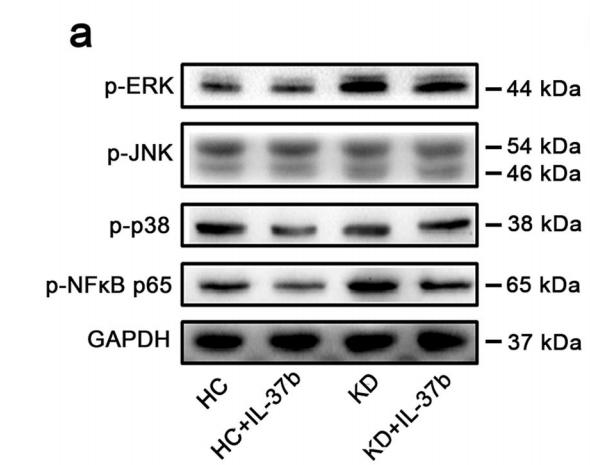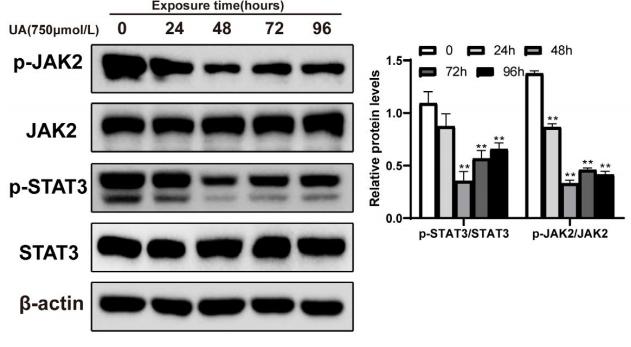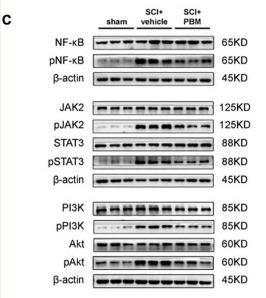Phospho-JAK2 (Tyr1007) Antibody - #AF3022
| Product: | Phospho-JAK2 (Tyr1007) Antibody |
| Catalog: | AF3022 |
| Description: | Rabbit polyclonal antibody to Phospho-JAK2 (Tyr1007) |
| Application: | WB IHC IF/ICC |
| Cited expt.: | WB |
| Reactivity: | Human, Mouse, Rat |
| Prediction: | Pig, Bovine, Horse, Sheep, Rabbit, Dog, Chicken, Xenopus |
| Mol.Wt.: | 120~140kD; 131kD(Calculated). |
| Uniprot: | O60674 |
| RRID: | AB_2834429 |
Product Info
*The optimal dilutions should be determined by the end user. For optimal experimental results, antibody reuse is not recommended.
*Tips:
WB: For western blot detection of denatured protein samples. IHC: For immunohistochemical detection of paraffin sections (IHC-p) or frozen sections (IHC-f) of tissue samples. IF/ICC: For immunofluorescence detection of cell samples. ELISA(peptide): For ELISA detection of antigenic peptide.
Cite Format: Affinity Biosciences Cat# AF3022, RRID:AB_2834429.
Fold/Unfold
JAK 2; JAK-2; JAK2; JAK2_HUMAN; Janus Activating Kinase 2; Janus kinase 2 (a protein tyrosine kinase); Janus kinase 2; JTK 10; JTK10; kinase Jak2; OTTHUMP00000043260; THCYT3; Tyrosine protein kinase JAK2; Tyrosine-protein kinase JAK2;
Immunogens
A synthesized peptide derived from human JAK2 around the phosphorylation site of Tyr1007.
- O60674 JAK2_HUMAN:
- Protein BLAST With
- NCBI/
- ExPASy/
- Uniprot
MGMACLTMTEMEGTSTSSIYQNGDISGNANSMKQIDPVLQVYLYHSLGKSEADYLTFPSGEYVAEEICIAASKACGITPVYHNMFALMSETERIWYPPNHVFHIDESTRHNVLYRIRFYFPRWYCSGSNRAYRHGISRGAEAPLLDDFVMSYLFAQWRHDFVHGWIKVPVTHETQEECLGMAVLDMMRIAKENDQTPLAIYNSISYKTFLPKCIRAKIQDYHILTRKRIRYRFRRFIQQFSQCKATARNLKLKYLINLETLQSAFYTEKFEVKEPGSGPSGEEIFATIIITGNGGIQWSRGKHKESETLTEQDLQLYCDFPNIIDVSIKQANQEGSNESRVVTIHKQDGKNLEIELSSLREALSFVSLIDGYYRLTADAHHYLCKEVAPPAVLENIQSNCHGPISMDFAISKLKKAGNQTGLYVLRCSPKDFNKYFLTFAVERENVIEYKHCLITKNENEEYNLSGTKKNFSSLKDLLNCYQMETVRSDNIIFQFTKCCPPKPKDKSNLLVFRTNGVSDVPTSPTLQRPTHMNQMVFHKIRNEDLIFNESLGQGTFTKIFKGVRREVGDYGQLHETEVLLKVLDKAHRNYSESFFEAASMMSKLSHKHLVLNYGVCVCGDENILVQEFVKFGSLDTYLKKNKNCINILWKLEVAKQLAWAMHFLEENTLIHGNVCAKNILLIREEDRKTGNPPFIKLSDPGISITVLPKDILQERIPWVPPECIENPKNLNLATDKWSFGTTLWEICSGGDKPLSALDSQRKLQFYEDRHQLPAPKWAELANLINNCMDYEPDFRPSFRAIIRDLNSLFTPDYELLTENDMLPNMRIGALGFSGAFEDRDPTQFEERHLKFLQQLGKGNFGSVEMCRYDPLQDNTGEVVAVKKLQHSTEEHLRDFEREIEILKSLQHDNIVKYKGVCYSAGRRNLKLIMEYLPYGSLRDYLQKHKERIDHIKLLQYTSQICKGMEYLGTKRYIHRDLATRNILVENENRVKIGDFGLTKVLPQDKEYYKVKEPGESPIFWYAPESLTESKFSVASDVWSFGVVLYELFTYIEKSKSPPAEFMRMIGNDKQGQMIVFHLIELLKNNGRLPRPDGCPDEIYMIMTECWNNNVNQRPSFRDLALRVDQIRDNMAG
Predictions
Score>80(red) has high confidence and is suggested to be used for WB detection. *The prediction model is mainly based on the alignment of immunogen sequences, the results are for reference only, not as the basis of quality assurance.
High(score>80) Medium(80>score>50) Low(score<50) No confidence
Research Backgrounds
Non-receptor tyrosine kinase involved in various processes such as cell growth, development, differentiation or histone modifications. Mediates essential signaling events in both innate and adaptive immunity. In the cytoplasm, plays a pivotal role in signal transduction via its association with type I receptors such as growth hormone (GHR), prolactin (PRLR), leptin (LEPR), erythropoietin (EPOR), thrombopoietin (THPO); or type II receptors including IFN-alpha, IFN-beta, IFN-gamma and multiple interleukins. Following ligand-binding to cell surface receptors, phosphorylates specific tyrosine residues on the cytoplasmic tails of the receptor, creating docking sites for STATs proteins. Subsequently, phosphorylates the STATs proteins once they are recruited to the receptor. Phosphorylated STATs then form homodimer or heterodimers and translocate to the nucleus to activate gene transcription. For example, cell stimulation with erythropoietin (EPO) during erythropoiesis leads to JAK2 autophosphorylation, activation, and its association with erythropoietin receptor (EPOR) that becomes phosphorylated in its cytoplasmic domain. Then, STAT5 (STAT5A or STAT5B) is recruited, phosphorylated and activated by JAK2. Once activated, dimerized STAT5 translocates into the nucleus and promotes the transcription of several essential genes involved in the modulation of erythropoiesis. Part of a signaling cascade that is activated by increased cellular retinol and that leads to the activation of STAT5 (STAT5A or STAT5B). In addition, JAK2 mediates angiotensin-2-induced ARHGEF1 phosphorylation. Plays a role in cell cycle by phosphorylating CDKN1B. Cooperates with TEC through reciprocal phosphorylation to mediate cytokine-driven activation of FOS transcription. In the nucleus, plays a key role in chromatin by specifically mediating phosphorylation of 'Tyr-41' of histone H3 (H3Y41ph), a specific tag that promotes exclusion of CBX5 (HP1 alpha) from chromatin.
Autophosphorylated, leading to regulate its activity. Leptin promotes phosphorylation on tyrosine residues, including phosphorylation on Tyr-813 (By similarity). Autophosphorylation on Tyr-119 in response to EPO down-regulates its kinase activity (By similarity). Autophosphorylation on Tyr-868, Tyr-966 and Tyr-972 in response to growth hormone (GH) are required for maximal kinase activity (By similarity). Also phosphorylated by TEC (By similarity). Phosphorylated on tyrosine residues in response to interferon gamma signaling. Phosphorylated on tyrosine residues in response to a signaling cascade that is activated by increased cellular retinol.
Endomembrane system>Peripheral membrane protein. Cytoplasm. Nucleus.
Ubiquitously expressed throughout most tissues.
Possesses 2 protein kinase domains. The second one probably contains the catalytic domain, while the presence of slight differences suggest a different role for protein kinase 1 (By similarity).
Belongs to the protein kinase superfamily. Tyr protein kinase family. JAK subfamily.
Research Fields
· Cellular Processes > Cell growth and death > Necroptosis. (View pathway)
· Cellular Processes > Cellular community - eukaryotes > Signaling pathways regulating pluripotency of stem cells. (View pathway)
· Environmental Information Processing > Signal transduction > PI3K-Akt signaling pathway. (View pathway)
· Environmental Information Processing > Signal transduction > Jak-STAT signaling pathway. (View pathway)
· Human Diseases > Drug resistance: Antineoplastic > EGFR tyrosine kinase inhibitor resistance.
· Human Diseases > Infectious diseases: Parasitic > Leishmaniasis.
· Human Diseases > Infectious diseases: Parasitic > Toxoplasmosis.
· Human Diseases > Infectious diseases: Bacterial > Tuberculosis.
· Human Diseases > Infectious diseases: Viral > Measles.
· Human Diseases > Infectious diseases: Viral > Influenza A.
· Human Diseases > Infectious diseases: Viral > Herpes simplex infection.
· Human Diseases > Cancers: Overview > Pathways in cancer. (View pathway)
· Organismal Systems > Immune system > Chemokine signaling pathway. (View pathway)
· Organismal Systems > Immune system > Th1 and Th2 cell differentiation. (View pathway)
· Organismal Systems > Immune system > Th17 cell differentiation. (View pathway)
· Organismal Systems > Nervous system > Cholinergic synapse.
· Organismal Systems > Endocrine system > Prolactin signaling pathway. (View pathway)
· Organismal Systems > Endocrine system > Adipocytokine signaling pathway.
References
Application: WB Species: Human Sample:
Application: WB Species: Rat Sample: hippocampus
Application: WB Species: Rat Sample:
Application: WB Species: rat Sample: DRG neurons
Application: WB Species: human Sample: L02 cells
Restrictive clause
Affinity Biosciences tests all products strictly. Citations are provided as a resource for additional applications that have not been validated by Affinity Biosciences. Please choose the appropriate format for each application and consult Materials and Methods sections for additional details about the use of any product in these publications.
For Research Use Only.
Not for use in diagnostic or therapeutic procedures. Not for resale. Not for distribution without written consent. Affinity Biosciences will not be held responsible for patent infringement or other violations that may occur with the use of our products. Affinity Biosciences, Affinity Biosciences Logo and all other trademarks are the property of Affinity Biosciences LTD.







![Fig. 5. MaR1 inhibits the activation of JAK2/STAT3 signaling pathway. A-C MaR1 deactivated JAK2/STAT3 pathway in hippocampus shown by Western blotting using JAK2/STAT3 antibodies (A) and quantitative analysis (B, C). One-way ANOVA, [pJAK2] F(3, 8) = 6.753, p = 0.0154; [pSTAT3] F(3, 8) = 5.325, p = 0.0245, n = 3. D,E MaR1 inactivated GSK3β pathway in hippocampus shown by Western blotting (D) and quantitative analysis (E). One-way ANOVA, [pS9] F(3, 8) = 7.565, p = 0.0112, n = 3. F Predicted STAT3′ s binding motifs on the promoter of IL-6 were examined by dual luciferase reporter assay. Unpaired t-test, [Motif3] t = 3.546 df = 4, p = 0.0116, n = 3. * p < 0.05; # p < 0.05. Data were presented as mean ± SEM. Phospho-JAK2 (Tyr1007) Antibody - Fig.](http://img.affbiotech.cn/uploads/202309/b985e1943685f09d74877983f436c508.png)

